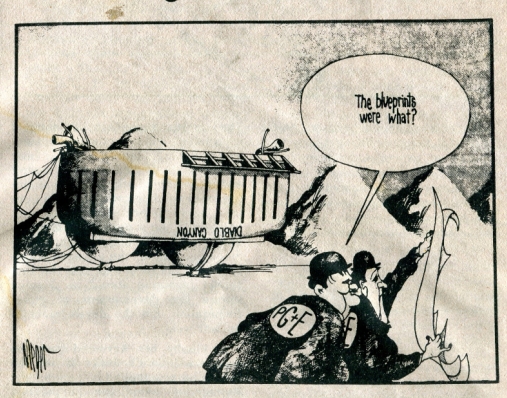Bob Van Scoy It’s About Times Staff / October-November 1981 / page 3
 According to PG&E, “the most rigorous design review in history” guarantees the safety of the Diablo Canyon nuclear plant. But that review apparently was not rigorous enough.
According to PG&E, “the most rigorous design review in history” guarantees the safety of the Diablo Canyon nuclear plant. But that review apparently was not rigorous enough.
On September 25, just before nuclear fuel was to be loaded into the reactor, plant engineers stumbled upon a major design error that called into question Diablo’s earthquake safety. The discovery also raised the disturbing possibility that there may be other undetected mistakes in the plant’s design or construction.
Embarrassed company officials revealed on September 28 that the wrong set of blueprints had been used in the design of seismic bracing for certain pipes in the Unit One reactor building. Since some of the pipes are essential parts of emergency cooling systems, preparations for fuel loading were halted when the error was discovered—a move that would have been ordered by the Nuclear Regulatory Commission (NRC) if PG&E hadn’t taken it voluntarily.
According to PG&E spokespeople, the problem originated several years ago when diagrams used for seismic analysis of the plant’s two reactor buildings were mistakenly switched, resulting in the Unit Two diagram being used to design bracing for the mirror-image Unit One. Needless to say, the same problem exists in the yet-unfinished Unit Two.
From PG&E’s standpoint the timing of the revelations couldn’t have been worse. The announcement was made on the last day of a two week long antinuclear blockade which focused national attention specifically on Diablo Canyon’s earthquake safety problems. As the NRC’ s Victor Stello observed, “This is obviously a very undesirable position for the company to find itself in.”
But the red faces weren’t limited to PG&E. The NRC, which had licensed the plant for low power operation just a few days earlier, had to explain how such a major slip-up had escaped the notice of federal regulators.
NRC Chair Nunzio Palladino’s reaction was, “It seems a little strange that this could happen.” He was disturbed, he said, that the error wasn’t discovered until after the plant was cleared for fuel loading and then only by chance. NRC spoke Jim Harichett was quoted as saying such problems “are not at all unprecedented,” but conceded that “this one is significant. It’s not minor piping.”
Reporters questioned the NRC staff about just how closely they checked up on PG&E’s work. They were told that the agency normally examines a utility’s calculation methods and system descriptions in detail —but doesn’t verify every design calculation and certainly doesn’t physically examine every part of the plant. Richard Vollmer, director of the NRC’s engineering division, told one reporter, “We send out an audit team that looks at the equipment and components, but we would not check out every pipe. We only do an audit review.”
The ” audit review” evidently missed not only the pipe support errors but also similar mistakes in the bracing of cable trays that carry power and control wiring for the reactor. The NRC was informed of this additional problem a few days after the first problems were found. NRC official Robert Faulkenberry was quoted as saying that the commission thought this problem was as serious as the first, since in an earthquake the cable trays might be shaken off the wall so that “the cables could break loose and lose the ability to carry the required electrical current.” The failure of vital instrumentation or control cables might worsen— or even cause— a nuclear accident.
Given the seriousness of the mistakes, the NRC asked relatively little of PG&E. In a meeting on October 9, it requested that the company provide information on the supports affected by the design error and its reasons for deciding whether to modify each one. It ordered Robert Cloud, a consultant for PG&E, to study past communications between the company and its seismic advisors to determine if there were other errors in designing the earthquake safety systems. Finally, Cloud was commissioned to study the entire plant for undetected errors and submit a report by the end of the year.
Critics feel that a much more extensive study should be done, conducted by consultants with no previous ties to PG&E. Attorney David Fleishacker, who represents local Diablo opponents, urged the NRC staff to “take time to check carefully what PG&E is doing . . . We need a really tough independent audit of that plant.”
It’s not clear how long the newly discovered problems will delay nuclear fuel loading at Diablo. PG&E proposes fixing the supports on 27 pipes, a process it estimated will take about 30 days. Fuel loading would begin about a week later. But it is likely that the delay will be longer, and plant opponents may be able to force the NRC to examine the issue more thoroughly before granting the plant a full-power operating license.
While anything that prevents Diablo’s operation is good news, there is darker side to PG&E’s misfortune demonstrated that despite the best efforts of the nuclear industry and supposedly “excessive” government regulation, nuclear mistakes still slip by. Some of those mistakes may not be discovered until too late.
SF Chronicle, 9/29-10/10/81 Oakland Tribune, 10/3/81
